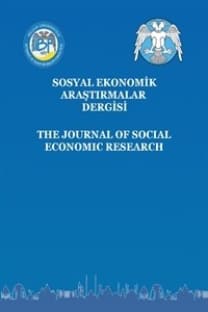İMALAT SANAYİ VE TEKSTİL SEKTÖRÜ İÇİN COBBDOUGLAS, CES VE TRANSLOG ÜRETİM FONKSİYONLARININ TAHMİNİ
Bu çalışmada, 1985-2001 dönemi yıllık verilerine dayanarak, Türk imalat sanayi ve onun en önemli alt sektörlerinden biri olan tekstil sektörüne ilişkin Cobb-Douglas (C-D), CES ve Translog üretim fonksiyonları tahmin edilmiş; ilgili sektörlerde üretim esnekliği, ölçeğe göre getiri ve ikâme esneklikleri bulunmuştur. Elde edilen sonuçlara göre, gerek imalat sanayi, gerekse tekstil sektöründe ölçeğe göre artan getiri gözlenmekle birlikte, tekstil sektöründe ölçeğe göre getiri (2.25), imalat sanayine kıyasla (1.62) daha yüksektir. CES üretim fonksiyonunda ikâme esneklikleri yaklaşık 1 olarak hesaplanmıştır. Sonuçlar, C-D üretim fonksiyonunun incelenen dönem itibariyle Türk imalat sanayi ve tekstil sektörünün üretim yapısını daha iyi açıklayan, dolayısıyla temsil kabiliyeti daha yüksek üretim fonksiyonu olduğuna işaret etmektedir. Bu sonuçlar, imalat sanayi ve tekstilde henüz tüketilmemiş kâr fırsatlarının olduğuna, tekstil sektöründe sermaye yoğun yatırımların daha cazip olacağına ve adı geçen sektörlerde işgücü reel ücretleri üzerinde belirli bir baskının varolacağını ima etmektedir.
Anahtar Kelimeler:
İmalat Sanayi Ve Tekstil Sektörü, Üretim Fonksiyonları, CES, C-D, Translog
This study estimates production function for manufacturing and textiles industries by using Cobb-Douglas, CES and Translog Functional Forms based on 1985-2001 data. By doing this, supply elasticities, returns to scale and substitution elasticities were obtained for these sectors. The results indicate that both industries reveal increasing returns to scale, though it is higher for textiles than manufacturing. Substitution elasticities were found to be around 1, which confirms the implicit assumption that C-D type production functions have substitution elasticity of 1. For the period in question C-D functional form was found to have a better explanatory power in explaining the production structure of Turkish manufacturing and textiles industries. These findings imply that there are still unexploited profit opportunities in manufacturing and textiles that capital-intensive investments will be more attractive in textiles, and there will be a certain pressure on real wages in these sectors due to relatively easier factor substitution possibilities.
Keywords:
Manufacturing Industry and Textiles, Production Functions, CES, C-D, Translog,
- ISSN: 2148-3043
- Yayın Aralığı: Yılda 2 Sayı
- Başlangıç: 2000
- Yayıncı: Selçuk Üniversitesi
Sayıdaki Diğer Makaleler
PERSONEL REJİMİNDE BÜROKRATİK MODELDEN İŞLETMECİ ANLAYIŞA GEÇİŞ
YÖNETİME KATILMA BİÇİMLERİ VE YEREL YÖNETİMLERDE DEMOKRATİK MEKANİZMALAR
İMALAT SANAYİ VE TEKSTİL SEKTÖRÜ İÇİN COBBDOUGLAS, CES VE TRANSLOG ÜRETİM FONKSİYONLARININ TAHMİNİ
ANTİK LİBERALİZM Mİ YOKSA MODERN SOFİZM Mİ?
TÜRKİYE’DEKİ İLLERİN SOSYO-EKONOMİK GELİŞMİŞLİK DÜZEYLERİNİN BELİRLENMESİ
Hülya ŞEN, Fatih ÇEMREK, Özer ÖZAYDIN
KAMU HİZMETİ SUNUMUNDA GÖNÜLLÜ KURULUŞLAR VE DEVLET
Zeynep KARAÇOR, Volkan ALPTEKİN
ÖRGÜTLERDE YILDIRMA UYGULAMALARI (MOBBİNG) VE ÇATIŞMA ARASINDAKİ İLİŞKİ
